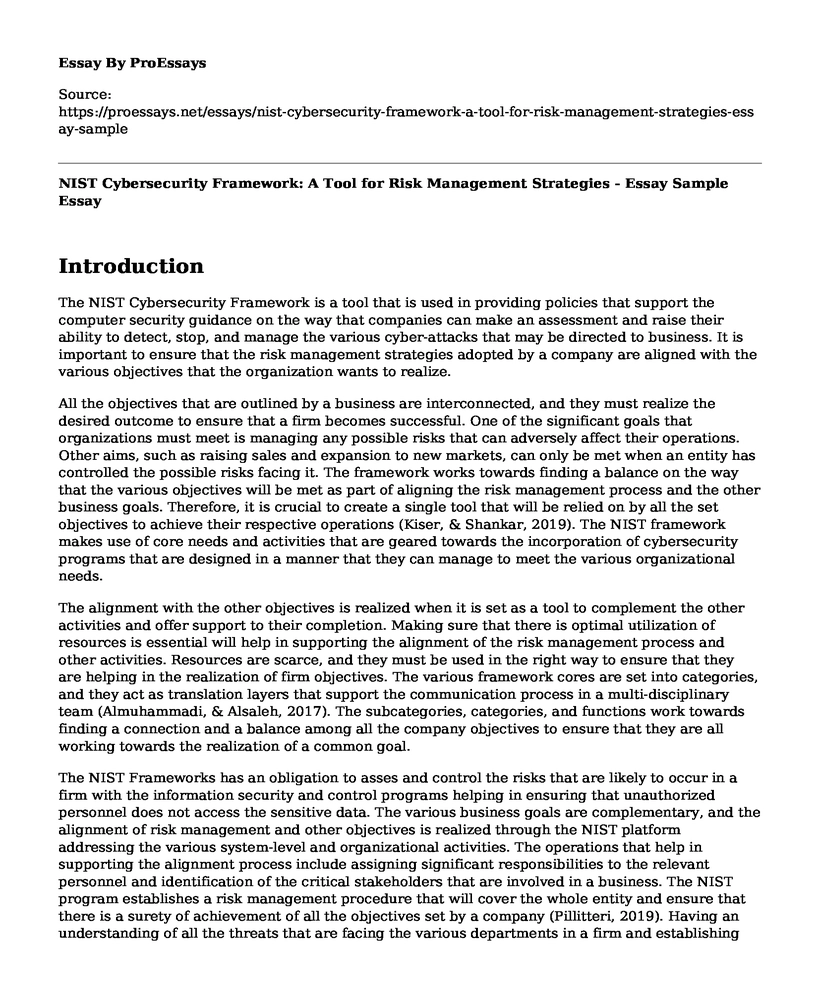Introduction
The NIST Cybersecurity Framework is a tool that is used in providing policies that support the computer security guidance on the way that companies can make an assessment and raise their ability to detect, stop, and manage the various cyber-attacks that may be directed to business. It is important to ensure that the risk management strategies adopted by a company are aligned with the various objectives that the organization wants to realize.
All the objectives that are outlined by a business are interconnected, and they must realize the desired outcome to ensure that a firm becomes successful. One of the significant goals that organizations must meet is managing any possible risks that can adversely affect their operations. Other aims, such as raising sales and expansion to new markets, can only be met when an entity has controlled the possible risks facing it. The framework works towards finding a balance on the way that the various objectives will be met as part of aligning the risk management process and the other business goals. Therefore, it is crucial to create a single tool that will be relied on by all the set objectives to achieve their respective operations (Kiser, & Shankar, 2019). The NIST framework makes use of core needs and activities that are geared towards the incorporation of cybersecurity programs that are designed in a manner that they can manage to meet the various organizational needs.
The alignment with the other objectives is realized when it is set as a tool to complement the other activities and offer support to their completion. Making sure that there is optimal utilization of resources is essential will help in supporting the alignment of the risk management process and other activities. Resources are scarce, and they must be used in the right way to ensure that they are helping in the realization of firm objectives. The various framework cores are set into categories, and they act as translation layers that support the communication process in a multi-disciplinary team (Almuhammadi, & Alsaleh, 2017). The subcategories, categories, and functions work towards finding a connection and a balance among all the company objectives to ensure that they are all working towards the realization of a common goal.
The NIST Frameworks has an obligation to asses and control the risks that are likely to occur in a firm with the information security and control programs helping in ensuring that unauthorized personnel does not access the sensitive data. The various business goals are complementary, and the alignment of risk management and other objectives is realized through the NIST platform addressing the various system-level and organizational activities. The operations that help in supporting the alignment process include assigning significant responsibilities to the relevant personnel and identification of the critical stakeholders that are involved in a business. The NIST program establishes a risk management procedure that will cover the whole entity and ensure that there is a surety of achievement of all the objectives set by a company (Pillitteri, 2019). Having an understanding of all the threats that are facing the various departments in a firm and establishing measures to control them is an essential tool to facilitate the alignment process.
The objectives set by a company are faced by different risks, and it is the duty of the NIST Framework to ensure that the right tools are instituted that will assist in supporting the achievement of these aims. Therefore, the alignment is realized by creating a platform that will offer support to the various departments that are implementing these objectives.
References
Almuhammadi, S., & Alsaleh, M. (2017). Information security maturity model for NIST cyber security framework. Computer Science & Information Technology (CS & IT), 7(3), 51-62.
Kiser, R., & Shankar, A. (2019). 2019 GPN All Hands Meeting: Building a NIST Risk Management Framework for HIPAA, CUI, and FISMA.
Pillitteri, V. (2019). The Next Generation Risk Management Framework (RMF 2.0): A Holistic Methodology to Manage Information Security, Privacy and Supply Chain Risk (No. ITL Bulletin February 2019). National Institute of Standards and Technology.
Cite this page
NIST Cybersecurity Framework: A Tool for Risk Management Strategies - Essay Sample. (2023, Apr 14). Retrieved from https://proessays.net/essays/nist-cybersecurity-framework-a-tool-for-risk-management-strategies-essay-sample
If you are the original author of this essay and no longer wish to have it published on the ProEssays website, please click below to request its removal:
- Security Measures, Laws and Privacy Essay
- Wireless Networks Questions Paper Example
- Committee on National Security Systems Model Paper Example
- Big Data Ethics Paper Example
- Designing a Database: Pros & Cons - Essay Sample
- Essay Sample on Darknet: Terror Groups and Criminal Gangs Exploit Anonymity
- Essay Example on Big Data Visualization: Unravelling the Beauty of the Large Data Sets







